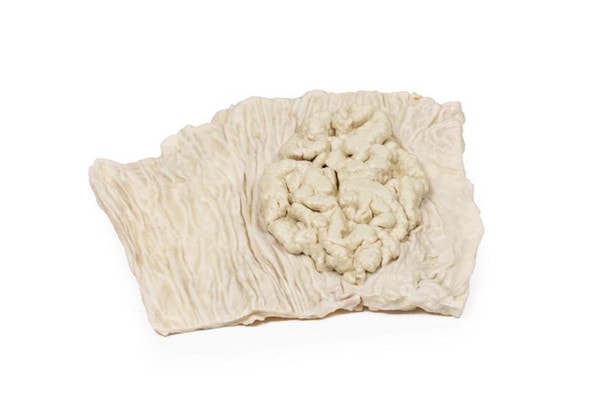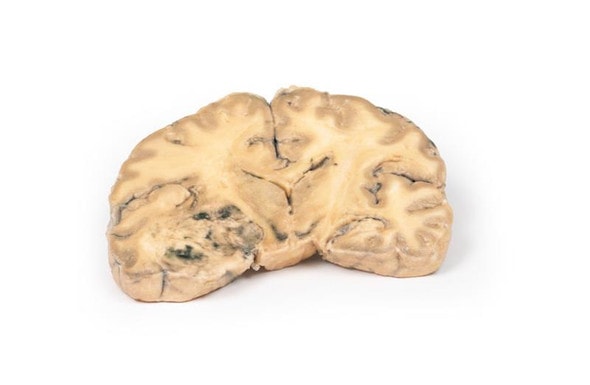Description
Developed from real patient case study specimens, the 3D printed anatomy model pathology series introduces an unmatched level of realism in human anatomy models. Each 3D printed anatomy model is a high-fidelity replica of a human cadaveric specimen, focusing on the key morbidity presentations that led to the deceasement of the patient. With advances in 3D printing materials and techniques, these stories can come to life in an ethical, consistently reproduceable, and easy to handle format. Ideal for the most advanced anatomical and pathological study, and backed by authentic case study details, students, instructors, and experts alike will discover a new level of anatomical study with the 3D printed anatomy model pathology series.
Clinical History
A 29-year-old male presented with a 22-month history of headaches and blurred vision. Examination revealed bi-temporal hemianopia and left VI nerve palsy. Skull X-ray showed erosion of most of the sphenoid body with some dorsum sellae and anterior clinoid process intact. Carotid angiography showed upward and lateral displacement of the anterior and middle cerebral arteries. Pneumoencephalography (a common imaging procedure used until the 1970s in which CSF is drained and replaced by air, oxygen or helium that acted as a contrast medium in X-ray examinations) showed upward displacement of the lateral and third ventricles from below. A craniotomy was performed but the patient died immediately afterwards.
Pathology
The brain specimen is sliced in the sagittal plane to the right of the falx cerebri, which remains in-situ. The pituitary gland has been completely replaced by a round tumor 4cm in maximum diameter. The tumor cut surface is pale brown and homogenous (except for an area of hemorrhage superiorly, likely caused by surgical trauma). The tumor has resulted in upward displacement of the midbrain. Tumor erosion has destroyed the sphenoid bone; thus, the sella turcica is enlarged (arrow). The optic chiasma is compressed by the tumor. Histologically, this tumor was a chromophobe adenoma arising from the anterior pituitary.
Further Information
This specimen is from an old case and the investigations used would now be considered antiquated. Modern investigation would include an initial brain CT followed by an MRI of the brain to further visualize the pituitary lesion prior to any surgical intervention.
Pituitary adenomas are the most common pituitary tumor and are mostly found in adults with peak incidence between 35-60 years. Primary carcinoma of the pituitary is exceedingly rare, and the pituitary is an uncommon site for metastases. Clinical manifestations of pituitary adenomas are related to local mass effect and tumor function. Local effects include increasing intracranial pressure (headache, nausea, and vomiting), sellar expansion, bony erosion, and compression of decussating nerve fibers in the optic chiasma, causing bitemporal hemianopia.
Pituitary adenomas can be functioning (i.e. associated with hormone excess) or non-functioning (i.e. without clinical symptoms of hormone excess). About 75% of adenomas are functional: usually secreting prolactin, growth hormone or ACTH. Secretion of TSH, LH and FSH from pituitary adenomas is exceedingly rare. Some adenomas can secrete two hormones: growth hormone and prolactin being the most common combination. Non-functional pituitary adenomas come to clinical attention later than those associated with endocrine abnormalities, and they may lead to hypopituitarism due to compression atrophy of the surrounding normal gland.
Advantages of 3D Printed Anatomical Models
- 3D printed anatomical models are the most anatomically accurate examples of human anatomy because they are based on real human specimens.
- Avoid the ethical complications and complex handling, storage, and documentation requirements with 3D printed models when compared to human cadaveric specimens.
- 3D printed anatomy models are far less expensive than real human cadaveric specimens.
- Reproducibility and consistency allow for standardization of education and faster availability of models when you need them.
- Customization options are available for specific applications or educational needs. Enlargement, highlighting of specific anatomical structures, cutaway views, and more are just some of the customizations available.
Disadvantages of Human Cadavers
- Access to cadavers can be problematic and ethical complications are hard to avoid. Many countries cannot access cadavers for cultural and religious reasons.
- Human cadavers are costly to procure and require expensive storage facilities and dedicated staff to maintain them. Maintenance of the facility alone is costly.
- The cost to develop a cadaver lab or plastination technique is extremely high. Those funds could purchase hundreds of easy to handle, realistic 3D printed anatomical replicas.
- Wet specimens cannot be used in uncertified labs. Certification is expensive and time-consuming.
- Exposure to preservation fluids and chemicals is known to cause long-term health problems for lab workers and students. 3D printed anatomical replicas are safe to handle without any special equipment.
- Lack of reuse and reproducibility. If a dissection mistake is made, a new specimen has to be used and students have to start all over again.
Disadvantages of Plastinated Specimens
- Like real human cadaveric specimens, plastinated models are extremely expensive.
- Plastinated specimens still require real human samples and pose the same ethical issues as real human cadavers.
- The plastination process is extensive and takes months or longer to complete. 3D printed human anatomical models are available in a fraction of the time.
- Plastinated models, like human cadavers, are one of a kind and can only showcase one presentation of human anatomy.
Advanced 3D Printing Techniques for Superior Results
- Vibrant color offering with 10 million colors
- UV-curable inkjet printing
- High quality 3D printing that can create products that are delicate, extremely precise, and incredibly realistic
- To improve durability of fragile, thin, and delicate arteries, veins or vessels, a clear support material is printed in key areas. This makes the models robust so they can be handled by students easily.
















